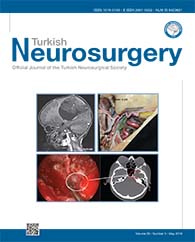2Baskent University, Department of Neurosurgery, Ankara, Turkey
3Ondokuz Mayis University, Department of Neurosurgery, Samsun, Turkey
4Maastricht University, Departments of Neurosurgery and Translational Neuroscience, Maastricht, Netherlands DOI : 10.5137/1019-5149.JTN.24348-18.3 AIM: To investigate microelectrode recording (MER)-induced microlesion effect (MLE) on the motor symptoms of 30 patients with Parkinsonâs disease (PD) who underwent deep brain stimulation of the subthalamic nucleus.
MATERIAL and METHODS: MER-induced MLE was evaluated based on the difference between tremor, rigidity, and bradykinesia scores in the preoperative off-state and intraoperative state following MER and before test stimulation.
RESULTS: MLE scores improved by 21.7% [left (L) side] and by 13.6% [right (R) side] from baseline (p<0.05). Tremor scores improved by 31.5% (L) and by 14.2% (R) (p<0.05), rigidity scores improved by 17.3% (L) and by 14.2% (R) (p<0.05) and bradykinesia scores improved by 20.6% (L) and by 11.5% (R) (p<0.05) from baseline. There was no significant difference between MLE and the number of microelectrodes used (p> 0.05).
CONCLUSION: MER-induced MLE improved motor symptoms and was not correlated with the number of microelectrodes used during the procedure.
Keywords : Parkinsonâ²s disease, Subthalamic nucleus, Deep brain stimulation, Microelectrode recording, Microlesion effect




